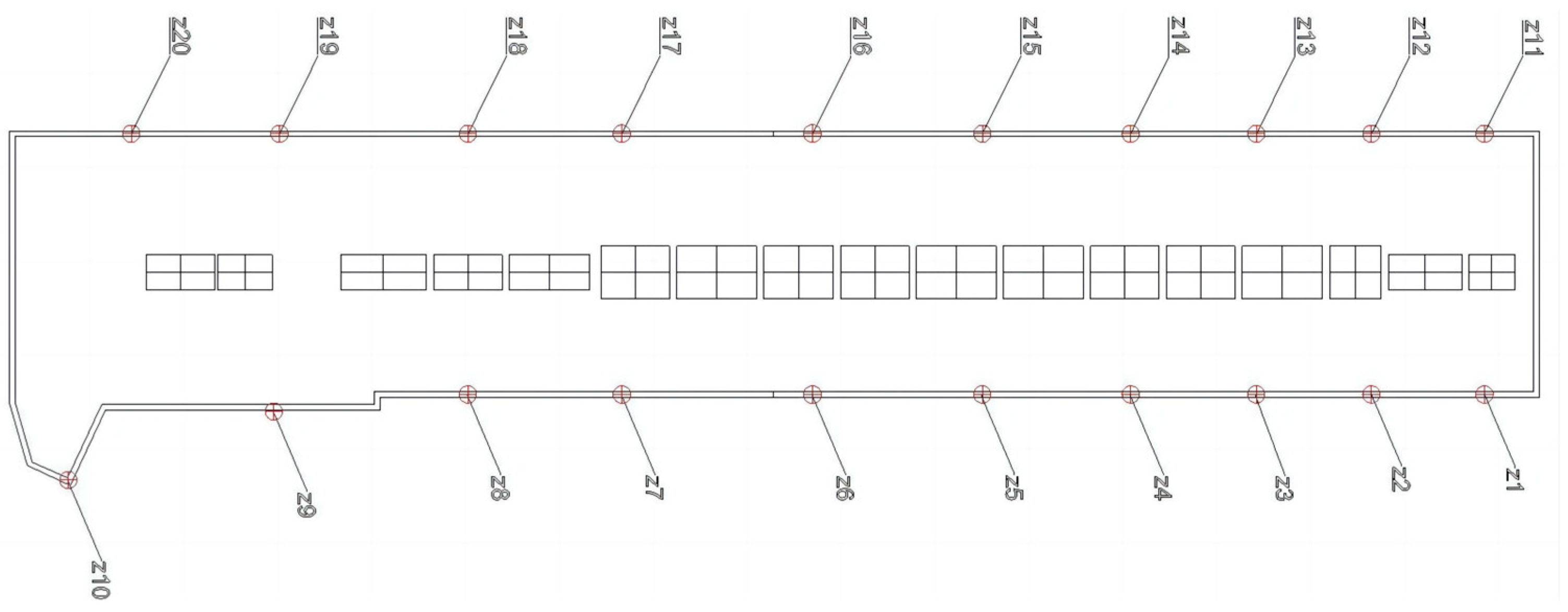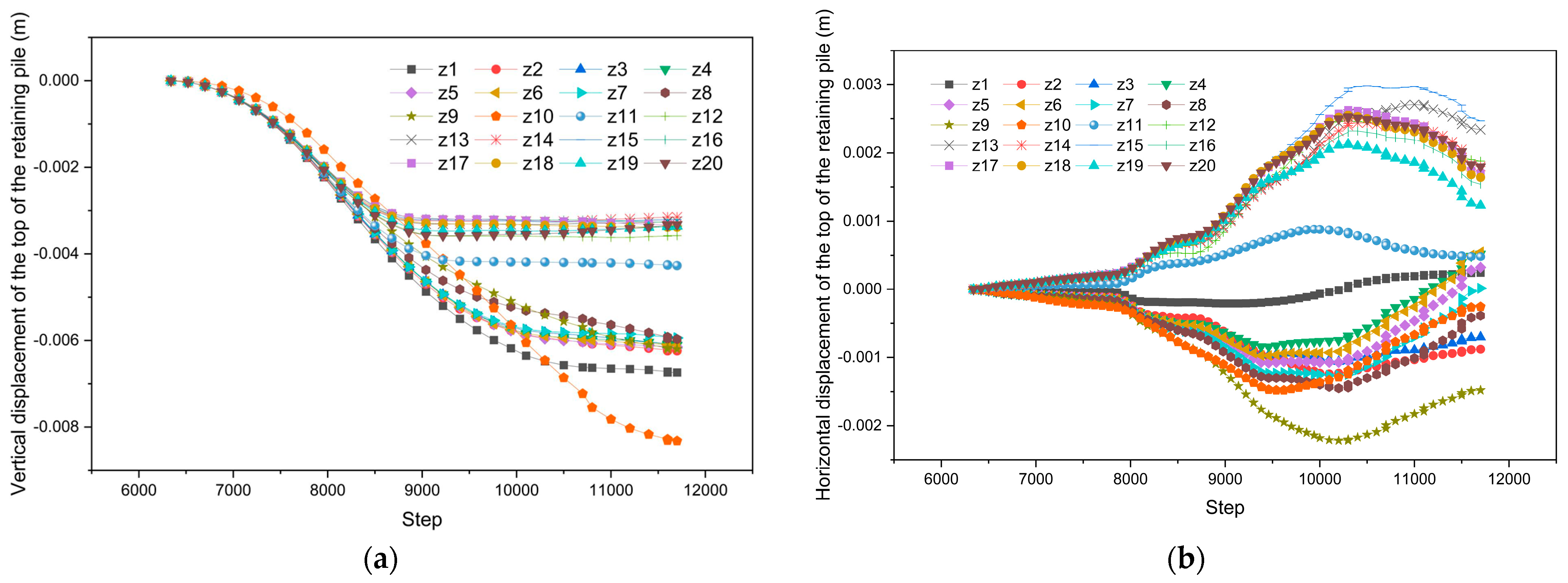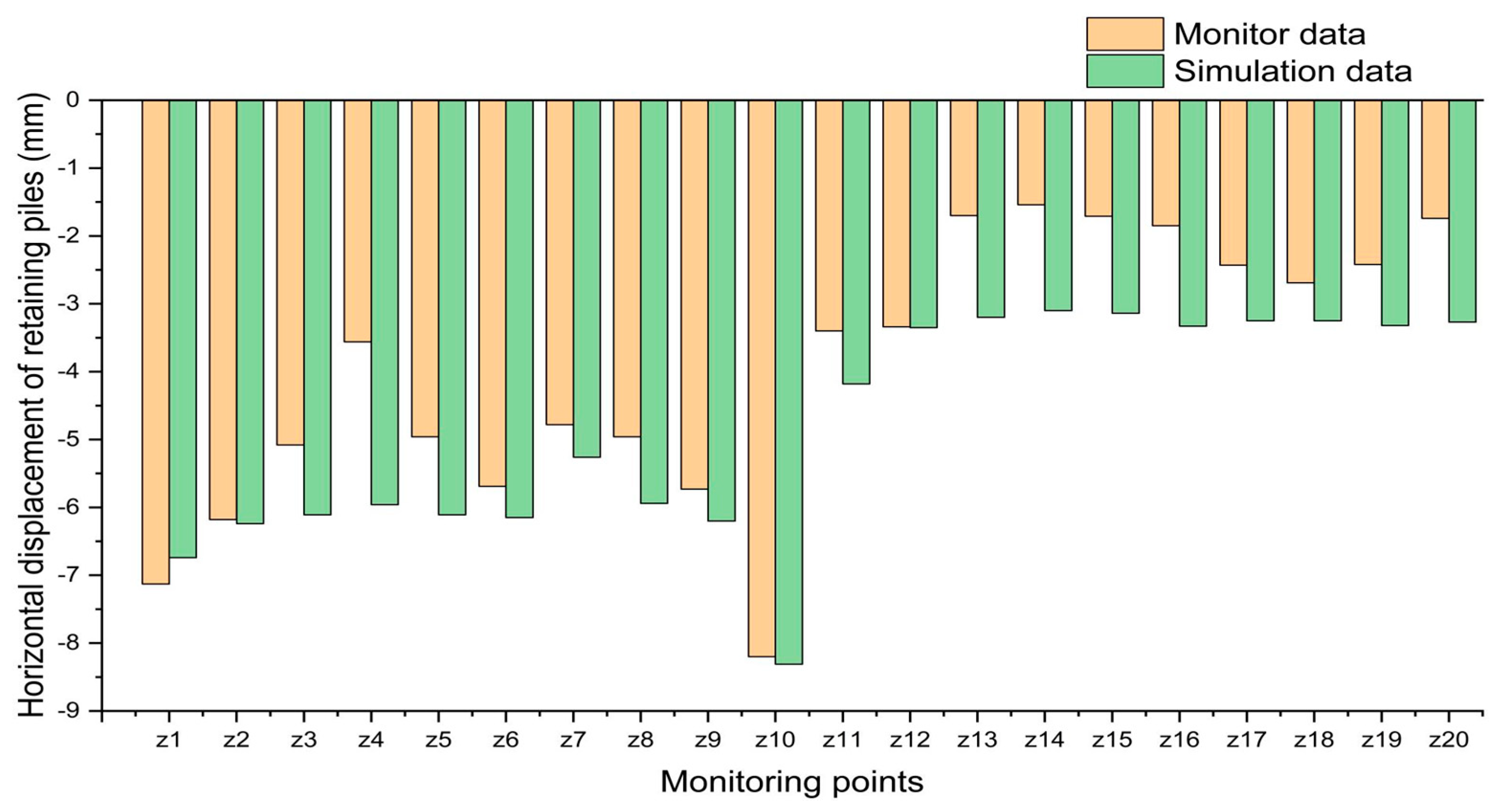Stability Analysis of Super-Large Special-Shaped Deep Excavation in Coastal Water-Rich Region Considering Spatial Variability of Ground Parameters
Abstract
:1. Introduction
2. Basic Theories
2.1. Digital Characterization of Random Fields
2.2. Soil Characterization Methods
3. Numerical Simulation
3.1. Computational Model
- First, the soil in the stratum is continuously and horizontally distributed.
- Second, the soil is isotropic, its stress–strain varies in the Elasto-Plastic range and obeys the Mohr–Coulomb yield criterion.
- Third, only the self-weight of the soil is considered, not other loads during construction, and the final consolidation settlement of the soil is not considered. The numerical simulation was carried out using finite difference software (i.e., FLAC3D 6.0) for 3D modelling, with solid units for soil and bored cast-in-place pile, and PILE units for lattice columns and larsen steel sheet piles.
3.2. Deterministic Analysis
3.3. Stochastic Analysis
4. Conclusions
- The effect of spatial variability of soil parameters can be effectively included in the study of envelope displacement and surface deformation problems resulting from foundation excavation construction when random field theory and numerical analysis are combined.
- Merely studying the mean function and correlation function of a random field cannot replace studying the entire random field, but they do describe the main statistical characteristics of the random field. Therefore, they often play an important role in solving practical engineering problems. The essence of random field theory is to use homogeneous normal distribution random fields to simulate the spatial distribution of geotechnical parameters, and to characterize the spatial variability and correlation of geotechnical parameters using variance, correlation function and correlation distance.
- The maximum axial force of the pit excavation support is distributed in the center of the buttress truss, while the minimum axial force of the buttress truss mainly occurs in the two sides, the overall distribution of the axial force is small in the two sides and large in the middle and the axial force is larger near the shaped area.
- The reason for the perimeter piles’ tendency to partially rebound out of the pit during the excavation of the bearing platform foundation pit is that, as a result of the soil being unloaded during the excavation process, the triaxial piles mixed with cement outside the bearing platform foundation pit were displaced horizontally to the pit under the active soil pressure of the surrounding soil, forming a “lever” with a specific point serving as a pivot point. This caused the soil outside the pit to bulge, which increased the perimeter piles’ passive soil pressure and partially offset some of the displacements into the pit.
- A uniform distribution and a Gaussian distribution are used to examine the impact of the shear index’s geographic variability on the stability of the foundation pit, provided that an appropriate shear strength index is chosen. By comparison of the soil layer displacement analysis, bored cast-in-place piles displacement analysis and support force analysis by taking spatial variability into account or not, it is discovered that doing so has no discernible effect on the shape of each curve; nonetheless, taking spatial variability into account results in a big displacement value and a tiny support axial force value.
- After taking into account the spatial variability, the soil layer may not deform symmetrically, and the soil will be more affected by the pit excavation in the area of low stiffness.
Author Contributions
Funding
Data Availability Statement
Acknowledgments
Conflicts of Interest
References
- Guo, P.; Gong, X.; Wang, Y.; Lin, H.; Zhao, Y. Analysis of observed performance of a deep excavation straddled by shallowly buried pressurized pipelines and underneath traversed by planned tunnels. Tunn. Undergr. Space Technol. 2023, 132, 104946. [Google Scholar] [CrossRef]
- Li, J.J.; Li, M.G.; Chen, H.B.; Chen, J.J. Numerical investigation of the effects of compressibility of gassy groundwater (CGG) on the performance of deep excavations in Shanghai soft deposits. Eng. Geol. 2023, 327, 107306. [Google Scholar] [CrossRef]
- Li, P.F.; Li, Z.; Ge, C.H.; Guo, F. Deformation characteristics and redundancy analysis of deep foundation pit excavation in sandy soil cover excavation reverse construction subway station. Tunn. Constr. 2023, 43, 98–108. [Google Scholar]
- Kog, Y.C. Deep Excavation in Soft Normally Consolidated Clay. Pract. Period. Struct. Des. Constr. 2023, 28, 04023001. [Google Scholar] [CrossRef]
- Tu, B.; Zheng, J.; Ye, S.; Shen, M. Study on Excavation Response of Deep Foundation Pit Supported by SMW Piles Combined with Internal Support in Soft Soil Area. Water 2023, 15, 3430. [Google Scholar] [CrossRef]
- Wang, D.; Ye, S.; Xin, L. Study on the Analysis of Pile Foundation Deformation and Control Methods during the Excavation of Deep and Thick Sludge Pits. Water 2023, 15, 3121. [Google Scholar] [CrossRef]
- Wu, G.Q.; Nie, J.G. Reliability analysis of karst foundation considering spatial variability of strata. J. Hunan Univ. 2022, 49, 45–53. [Google Scholar]
- Wu, Y.X.; Zhou, X.H.; Gao, Y.F.; Zhang, L.; Yang, J. Effect of soil variability on bearing capacity accounting for non-stationary characteristics of undrained shear strength. Comput. Geotech. 2019, 110, 199–210. [Google Scholar] [CrossRef]
- Gan, X.L.; Gong, X.N.; Liu, N.W.; Yu, J.L.; Li, W.B. Random analysis method for nonlinear interaction between shield tunnel and spatially variable soil. Comput. Geotech. 2023, 166, 105964. [Google Scholar] [CrossRef]
- Lumb, P. The variability of natural soils. Can. Geotech. J. 2011, 3, 74–97. [Google Scholar] [CrossRef]
- Vanmarcke, E.H. Probabilistic modeling of soil profiles. J. Geotech. Eng. Div. 1977, 103, 1227–1246. [Google Scholar] [CrossRef]
- Vanmarcke, E.H. Random Fields: Analysis and Synthesis; MIT Press: Cambridge, MA, USA, 1983; pp. 1–382. [Google Scholar]
- Zhang, J.Z.; Wang, H.J.; Liu, F.S. Computer simulation and engineering application of soil-parameter random field in geotechnical engineering. J. Water Resour. Arch. Eng. 2017, 15, 8–13. [Google Scholar]
- Jiang, X.; Xiao, Y.; Zhou, X.D.; Zhao, X.D. The application of random field theory in reliability evaluation of vacuum preloaded soft soil foundation. Soil Eng. Found. 2022, 36, 230–234. [Google Scholar]
- Cheng, H.Z.; Chen, J.; Li, J.B. Study on surface deformation induced by shield tunneling based on random field theory. J. Rock Mech. Eng. 2016, 35, 4256–4264. [Google Scholar]
- Zhang, X.Y.; Shi, C.H.; Sun, X.H.; Peng, L.M.; Zheng, K.Y. Analysis of Surface Deformation Characteristics during Pipe Jacking Tunnel Construction Based on Random Field Theory. J. Cen. South Univ. 2023, 54, 2174–2189. [Google Scholar]
- Gan, X.L.; Yu, J.L.; Bezuijen, A.; Gong, X.N.; Wang, C.C. Tunneling-induced longitudinal responses of existing tunnel with discontinuities in structure stiffness. Transp. Geotech. 2023, 42, 101113. [Google Scholar] [CrossRef]
- Zheng, J.J.; Qiao, Y.Q.; Zhang, R.J. Effect of spatial variability of engineering properties on holistic performance of passive zone improvement for deep excavation in soft soil. J. Civil Environ. Eng. 2019, 41, 1–8. [Google Scholar]
- Wen, G.; Wang, Q.; Chen, F.y. Reliability analysis of slopes considering spatial variability of rock mass and random response study of anti slip piles. Rock Soil Mech. 2021, 42, 3157–3168. [Google Scholar]
- Cheng, Y.G.; Chang, X.L.; Li, D.Q. Deformation stochastic analysis of tunnel surrounding rock considering its spatial randomness. J. Rock Mech. Eng. 2012, 31, 2767–2775. [Google Scholar]
- Cheng, H.Z.; Chen, J.; Hu, Z.F. Evaluation of safety of buildings above tunnels accounting for spatial variability of soil properties. J. Geotech. Eng. 2017, 39, 75–78. [Google Scholar]
- Seyedpour, S.M.; Henning, C.; Kirmizakis, P.; Herbrandt, S.; Ickstadt, K.; Doherty, R.; Ricken, T. Uncertainty with Varying Subsurface Permeabilities Reduced Using Coupled Random Field and Extended Theory of Porous Media Contaminant Transport Models. Water 2023, 15, 159. [Google Scholar] [CrossRef]
- Lu, H.; Li, H.; Meng, X. Spatial Variability of the Mechanical Parameters of High-Water-Content Soil Based on a Dual-Bridge CPT Test. Water 2022, 14, 343. [Google Scholar] [CrossRef]
- Hwang, J.; Lee, H.; Lee, K. Effects of Nonhomogeneous Soil Characteristics on the Hydrologic Response: A Case Study. Water 2020, 12, 2416. [Google Scholar] [CrossRef]
- Wang, G. Analysis of Slope Reliability Simulation Based on Covariance Decomposition Method. Rural Econ. Sci. Tech. 2020, 31, 67–69. [Google Scholar]
- Liu, B.C.; Bao, H.; Yao, F.Z. Analysis of the impact of tunnel excavation on uneven settlement and surface deformation of nearby buildings based on random field theory. Henan Sci. 2020, 38, 1258–1263. [Google Scholar]
- Wang, J.W.; Zhou, S.; Chen, F. Calculation and analysis of soil properties related distance of soft clay in Ningbo. Yangtze River 2020, 51, 208–212+220. [Google Scholar]
- Yan, S.W.; Zhu, H.X.; Liu, R. Study on application of random field theory to reliability analysis. J. Geotech. Eng. 2006, 12, 2053–2059. [Google Scholar]
- Gui, Z.P. Practical Evaluation Method for Deformation of Deep Foundation Pits in Soft Soil Considering Soil Properties and Randomness of Construction Parameters. Ph.D. Thesis, Huazhong University of Science and Technology, Wuhan, China, 2020. [Google Scholar]
- Wang, M.X.; Wu, Q.; Li, D.Q.; Du, W.Q. Numerical-based seismic displacement hazard analysis for earth slopes considering spatially variable soils. Soil Dyn. Earth. Eng. 2023, 171, 107967. [Google Scholar] [CrossRef]
- Zhang, P.S.; Shi, J.Y. Analysis of effects of space variability of parameters on soil deformation around the deep exception. J. Under. Space Eng. 2008, 1, 111–115+137. [Google Scholar]
- Wang, Z.S.; Chen, J.; Rong, H. Characterization and modeling methods for anisotropic random fields of soil parameters. J. Comput. Mech. 2021, 38, 29–36. [Google Scholar]
- Wei, Y.J.; Niu, G.; Dong, J.K. Research on the Engineering Application of Artificial Freezing Method in Shield Tunneling Reception in Soft and Rich Water Strata. Eng. Constr. 2021, 35, 819–823. [Google Scholar]
- Wang, Y.; Chen, S.; Ouyang, J.; Li, J.; Zhao, Y.; Lin, H.; Guo, P. Predicting Ground Surface Settlements Induced by Deep Excavation under Embankment Surcharge Load in Flood Detention Zone. Water 2022, 14, 3868. [Google Scholar] [CrossRef]
- Ren, D.W.; Zeng, L.L.; Zhang, H.; Li, C.T. Applicability study of equivalent models for spatial variability of geotechnical parameters. J. Wuhan Univ. Technol. 2023, 47, 540–544. [Google Scholar]
- Liu, Z.; He, P.; Zhang, A.Q. Research on the Influence of Soil Mechanics Parameters on Stratum Disturbance with Dynamic Changes of Tunnel Construction. Mod. Tunn. Technol. 2017, 54, 131–136. [Google Scholar]
- Feng, Z.J.; Li, D.; Jiang, G. Stability analysis of secondary excavation of high slopes based on reliability theory. Sci. Technol. 2023, 19, 130–136. [Google Scholar]
- Zhang, L.S.; Li, D.Q.; Cao, Z.J.; Tang, X.S. Efficient Monte Carlo analysis method for reliability of foundation pit deformation considering statistical uncertainty. J. Wuhan Univ. 2019, 52, 207–215. [Google Scholar]
- Yan, L.; Wang, Q.; Liu, L.J. Reliability analysis of soil slopes based on random field theory. Water Conser. Sci. Econ. 2023, 29, 13–16+28. [Google Scholar]
- Wu, G.F.; Chen, C.; Wang, X. Slope stability analysis based on random field theory and strength reduction method. Eng. Constr. Stand. 2021, S1, 111–115. [Google Scholar]










| Construction Simulation Steps | Construction Description | Model Operation |
|---|---|---|
| 1 | Initial stress balance | Activate the silt layer and clay layer, set boundary conditions |
| 2 | Bored cast-in-place pile and enclosure construction | Activate structural unit (pile) |
| 3 | Excavation of the foundation pit of the bridge in the framework of Wenhua Road | Assign a 7 m empty model and excavate in two steps. The first step is to activate the beam unit, and the second step is to excavate to the bottom of the pit |
| 4 | Excavation of foundation pit for medium bridge bearing platform | Assign empty models to each bearing platform foundation pit to solve the balance |
| Soil Type | Thickness (m) | Density (kg/m3) | Internal Friction Angle (°) | Cohesion (kPa) | Compression Modulus (MPa) |
|---|---|---|---|---|---|
| Clay ①1 | 2 | 1840 | 11.8 | 20.4 | 3.45 |
| Mucky silty clay ②1 | 4 | 1800 | 15.6 | 8.7 | 3.22 |
| Silt ③1 | 8 | 1620 | 9.0 | 9.7 | 1.63 |
| Silt ③2 | 12 | 1630 | 13.7 | 9.3 | 1.78 |
| Mucky silty clay ②2 | 14 | 1790 | 17.5 | 13.5 | 3.05 |
| Soil Type | Cohesion (kPa) | Internal Friction Angle (°) | ||
|---|---|---|---|---|
| Mean Value μc | CV λc | |||
| Clay ①1 | 20.4 | 0.198 | 11.8 | 0.136 |
| Mucky silty clay ②1 | 8.7 | 0.265 | 15.6 | 0.188 |
| Silt ③1 | 9.7 | 0.075 | 9.0 | 0.088 |
| Silt ③2 | 9.3 | 0.047 | 13.7 | 0.131 |
| Mucky silty clay ②2 | 13.5 | 0.181 | 17.5 | 0.187 |
Disclaimer/Publisher’s Note: The statements, opinions and data contained in all publications are solely those of the individual author(s) and contributor(s) and not of MDPI and/or the editor(s). MDPI and/or the editor(s) disclaim responsibility for any injury to people or property resulting from any ideas, methods, instructions or products referred to in the content. |
© 2023 by the authors. Licensee MDPI, Basel, Switzerland. This article is an open access article distributed under the terms and conditions of the Creative Commons Attribution (CC BY) license (https://creativecommons.org/licenses/by/4.0/).
Share and Cite
Xu, Z.; Guo, S.; Guo, L.; Guo, P.; Ding, H.; Liu, K.; Xu, B.; Wu, B.; Wu, W.; Wang, Y. Stability Analysis of Super-Large Special-Shaped Deep Excavation in Coastal Water-Rich Region Considering Spatial Variability of Ground Parameters. Water 2024, 16, 98. https://doi.org/10.3390/w16010098
Xu Z, Guo S, Guo L, Guo P, Ding H, Liu K, Xu B, Wu B, Wu W, Wang Y. Stability Analysis of Super-Large Special-Shaped Deep Excavation in Coastal Water-Rich Region Considering Spatial Variability of Ground Parameters. Water. 2024; 16(1):98. https://doi.org/10.3390/w16010098
Chicago/Turabian StyleXu, Zaixing, Shimin Guo, Leilei Guo, Panpan Guo, Huying Ding, Kui Liu, Bao Xu, Bangbiao Wu, Wenbing Wu, and Yixian Wang. 2024. "Stability Analysis of Super-Large Special-Shaped Deep Excavation in Coastal Water-Rich Region Considering Spatial Variability of Ground Parameters" Water 16, no. 1: 98. https://doi.org/10.3390/w16010098






